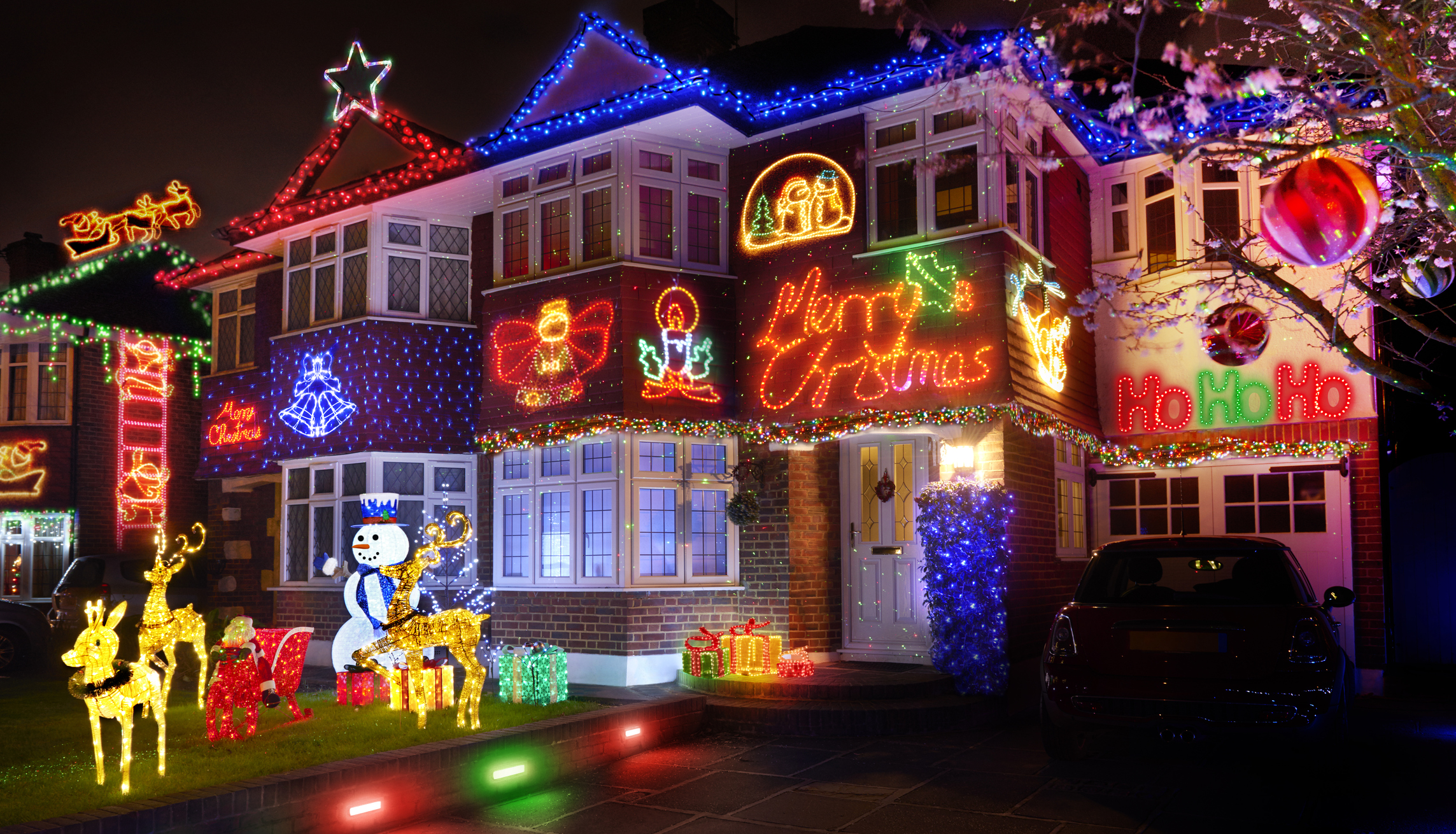Christmas Lights and Your Energy Bill: How to Save Money
These Christmas lights tips can maintain that holiday glow while reducing your power bill.

Erin Bendig

Christmas lights are a festive sign of the season, but do you know how much they cost you to run during the holidays? The U.S. Department of Energy (DoE) reports that lighting accounts for around 15% of an average home's electricity use. And at a time when inflation is still high and average Christmas tree prices have shot up 10%, every little bit helps.
So we've rounded up some helpful energy statistics and tips on how you can whittle down your Christmas lights' impact on your bottom line.
Christmas lights: How much do they cost to run
According to the U.S. Energy Information Administration (EIA),
From just $107.88 $24.99 for Kiplinger Personal Finance
Become a smarter, better informed investor. Subscribe from just $107.88 $24.99, plus get up to 4 Special Issues

Sign up for Kiplinger’s Free Newsletters
Profit and prosper with the best of expert advice on investing, taxes, retirement, personal finance and more - straight to your e-mail.
Profit and prosper with the best of expert advice - straight to your e-mail.
The average monthly electricity bill for customers in the United States increased 13% in 2022 from 2021, rising to $137 per month from $121 a month. Because of this, the cost to run your Christmas lights will be more expensive than in previous years. In fact, our colleagues at Tom's Guide report that since 2021, the national average cost of running Christmas lights has increased by $1.93, or 13%, bringing it to $16.48 in 2022.
To calculate your own festive light bill, use the following formula:
[wattage/1000 x time in hours] x cost per kWh in cents = cost to run Christmas lights
Tom's Guide explains that if you plug in your lights for a few hours (5 p.m. to 11 p.m.) each day in December, your energy bills could increase by the following amounts:
- Average decorations with LED lights: $5 to $7 increase
- Average decorations with incandescent lights: $33 increase
- Elaborate decorations using LED lights: $47 increase
- Elaborate decorations using incandescent lights: $350 increase
Use LED Christmas lights to save money
The DoE estimates that it costs $0.27 to light a 6-foot tree for 12 hours a day, for 40 days, with LEDs, compared to $10 for incandescent lights. But who isn't fed up with their Christmas tree before 40 days are up?
Duke Energy also illustrates just how much you can save by making the switch from incandescent bulbs to LED ones. If you use four 100-bulb strands of C-9 incandescent lights for six hours a day, on average you’d pay $1.68 per day. However, if you switched to all LED lighting, the average cost per day would only be $0.24.
As you can see in the list above, the type of bulb you choose can help you save real money during the holiday season. While many older lights are made with incandescent bulbs, switching to LED lights can help you cut your costs drastically.
Southern California Edison (SCE), one of the largest U.S. utility companies, reports that energy costs can double based on the type of Christmas lights you choose. SCE contends that LEDs are less expensive and last much longer than standard C-7 bulbs or mini-lights. LEDs are also much cooler and safer since there's no filament or breakable glass.
SCE adds that certain LED holiday lights can be used for up to 200,000 hours, and that bright, colorful LEDs can reduce holiday lighting costs by up to 90%. Five strings of LED lights can cost only 80 cents per month to operate versus nearly $20 per month for five strings of C-7 lights.
The same LED string could still be in use 40 holiday seasons from now, according to DoE.
Try solar Christmas lights to save more
Solar Christmas lights are a way to save even more money over the long term on your holiday energy bills. The DoE explains that outdoor solar lights use solar cells, which convert sunlight into electricity. The electricity is stored in batteries for use at night. So after spending an initial $10-$50 for a basic solar light set (according to Google Shopping), you could enjoy free Christmas lighting for your home every December.
Just do your research before buying. The DoE cautions that "nightly run time" listings on most outdoor solar lighting systems are based on specific sunlight conditions. Less sunny regions, especially in the winter, can expect shorter runtime per night than average. Operating times in the winter months may vary as much as 30%–50% unless the solar lighting system has been sized specifically for winter operation.
For more energy-saving content, check out our home savings hub.
Related content
Profit and prosper with the best of Kiplinger's advice on investing, taxes, retirement, personal finance and much more. Delivered daily. Enter your email in the box and click Sign Me Up.

Ben Demers manages digital content and engagement at Kiplinger, informing readers through a range of personal finance articles, e-newsletters, social media, syndicated content, and videos. He is passionate about helping people lead their best lives through sound financial behavior, particularly saving money at home and avoiding scams and identity theft. Ben graduated with an M.P.S. from Georgetown University and a B.A. from Vassar College. He joined Kiplinger in May 2017.
- Erin BendigPersonal Finance Writer
-
 The SEC Is Concerned for Older Investors and Retirement Savers. Here's What You Should Know
The SEC Is Concerned for Older Investors and Retirement Savers. Here's What You Should KnowThe SEC focusing on older investors, retirement and college savers, and private securities. Here's how those changes impact you.
-
 Vesting, Catch-Ups and Roths: The 401(k) Knowledge Quiz
Vesting, Catch-Ups and Roths: The 401(k) Knowledge QuizQuiz Test your understanding of key 401(k) concepts with our quick quiz.
-
 Why You Should Pay Attention to Company Guidance
Why You Should Pay Attention to Company GuidanceUnderstanding how corporate profit forecasts affect analysts’ estimates and stock ratings can help you make investment decisions.
-
 The 'Scrooge' Strategy: How to Turn Your Old Junk Into a Tax Deduction
The 'Scrooge' Strategy: How to Turn Your Old Junk Into a Tax DeductionTax Deductions We break down the IRS rules for non-cash charitable contributions. Plus, here's a handy checklist before you donate to charity this year.
-
 Don't Waste Your Money on Bad Gifts. Try This Instead.
Don't Waste Your Money on Bad Gifts. Try This Instead.Holiday Happiness These strategies, backed by behavioral finance, can help you find presents that your loved ones will truly enjoy.
-
 Protect Your Family From Costly Festive Fails With These Holiday Tips
Protect Your Family From Costly Festive Fails With These Holiday TipsHaving people over this holiday season? Before opening the door to guests, here are some perils to prepare for in advance.
-
 Have This Conversation to Save Your Family's Money This Holiday Season
Have This Conversation to Save Your Family's Money This Holiday SeasonWhile your family is together, talk about the risks of sophisticated financial scams.
-
 I Won’t Be Handing Out Gift Cards This Christmas. Here’s Why
I Won’t Be Handing Out Gift Cards This Christmas. Here’s WhyGift cards are usually considered a safe bet at Christmas, but in these strained times, how can you be sure your gift won't go to waste?
-
 Is A White Elephant Gift Exchange Right For Your Group?
Is A White Elephant Gift Exchange Right For Your Group?Feature Discover the fun, quirks and festive alternatives to white elephant exchanges — and make your holiday gathering unforgettable.
-
 Four Christmas Flight Booking Tips
Four Christmas Flight Booking TipsFollow these Christmas flight booking tips from Phil Dengler, co-owner of the Vacationer.
-
 Holiday Tipping Guide: Who to Tip (And How Much?)
Holiday Tipping Guide: Who to Tip (And How Much?)Holiday tipping guide for all of the hard working people that make your life easier.